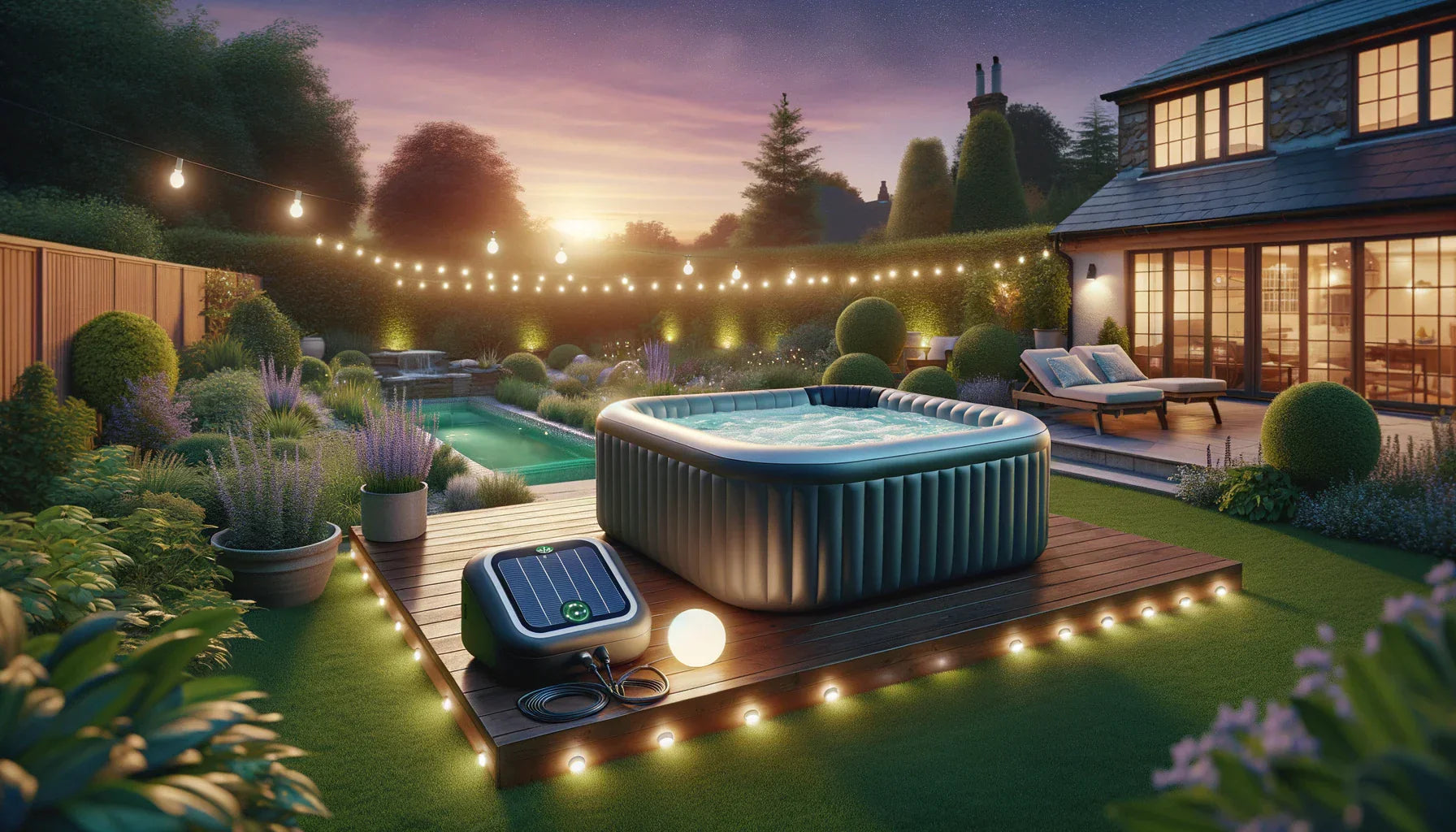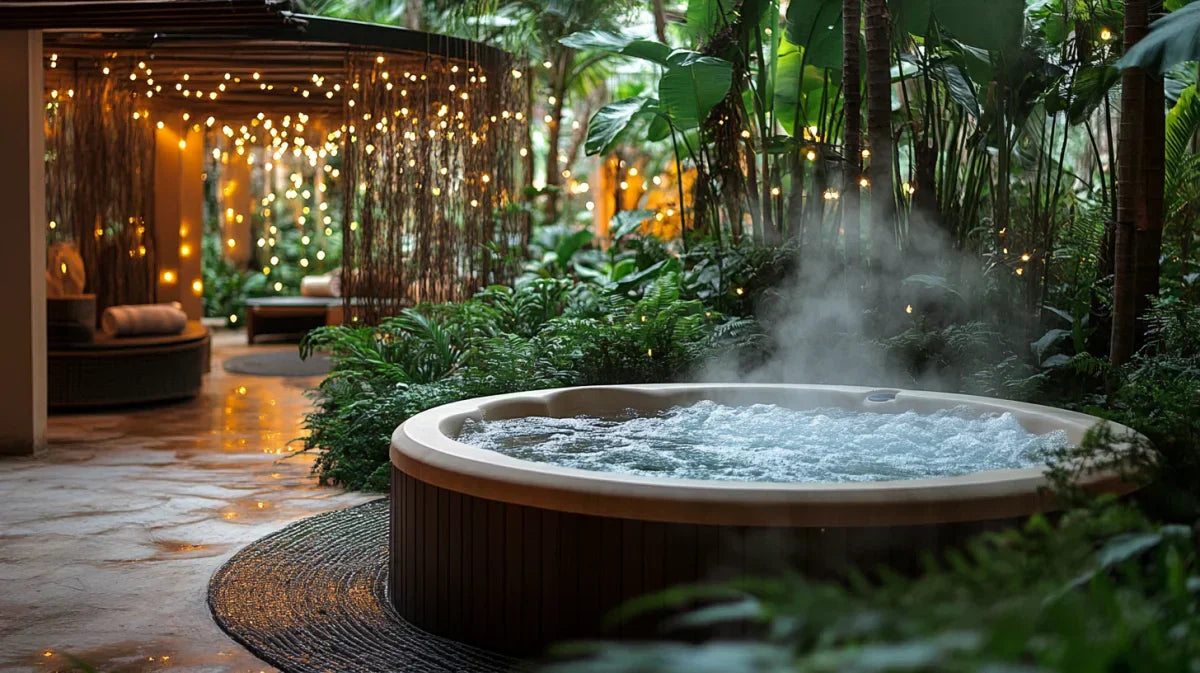Introduction to Energy Efficiency in Inflatable Hot Tubs
The Importance of Energy Conservation in Hot Tub Usage
In the tranquil evenings or on leisurely weekends throughout the UK, there's nothing quite like sinking into the warm embrace of an inflatable hot tub. But along with the comfort and relaxation, it's crucial to be mindful of energy consumption. Energy conservation is significant not only for reducing utility bills but also for lessening our environmental footprint. We understand the importance of enjoying your home luxuries in a sustainable manner, which is why we're dedicated to providing you with effective tips to help make your inflatable hot tub more energy-efficient.
Overview of Energy Consumption in Inflatable Hot Tubs
Inflatable hot tubs are a popular choice due to their affordability and convenience. However, they can be quite energy-intensive, especially during colder months. The energy consumption of these tubs primarily stems from heating the water to the desired temperature and maintaining it. This process can lead to high energy usage if not managed properly. We're here to guide you through various strategies to keep your inflatable hot tub warm without incurring excessive energy costs.
Insulation as the Key to Energy Saving
The Role of Insulation in Retaining Heat
Insulation is the cornerstone of energy saving for inflatable hot tubs. It significantly reduces the rate at which heat escapes from the water surface and the tub's body, ensuring that the water stays warmer for longer periods without continuous heating. Insulation comes in various forms, from covers to ground mats, and plays a crucial role in maintaining your hot tub's temperature efficiently.
Table: Types of Insulation and Their Effectiveness
| Insulation Type | Heat Retention Level | Additional Benefits |
|---|---|---|
| Covers | High | Protects from debris |
| Ground Mats | Medium | Provides cushioning |
| Thermal Blankets | High | Easy to use |
Types of Insulation for Inflatable Hot Tubs
Selecting the right type of insulation can make a significant difference in your hot tub's energy consumption. Insulated hot tub covers, for instance, act as a barrier, keeping heat from escaping when the tub is not in use. Similarly, using an insulated base or thermal mat underneath your hot tub adds another layer of heat retention from the ground up. We also recommend insulated jackets that wrap around the tub's exterior for added insulation.
Best Practices for Insulating Your Inflatable Hot Tub
To maximize the benefits of insulation, it's essential to use these products properly. Always cover your hot tub when it's not in use, ensuring the cover fits snugly without gaps. Place a thermal mat under the hot tub before filling it with water to provide a continuous layer of insulation from the base. For additional protection against heat loss, consider using an insulated hot tub jacket that complements your tub's design.
Energy-Efficient Accessories for Inflatable Hot Tubs
Insulated Covers: A Must-Have Accessory
An insulated cover is one of the most effective accessories for saving energy. Not only does it keep the heat in, but it also prevents debris from entering the water, maintaining its cleanliness and reducing the need for frequent water changes and heating from scratch. We offer a variety of insulated hot tub covers that cater to different brands and sizes, ensuring you find the perfect fit for your inflatable hot tub.
Table: Benefits of Insulated Hot Tub Covers
| Benefit | Description |
|---|---|
| Heat Retention | Maintains water temperature, reducing heating needs |
| Protection from Elements | Shields from wind, rain, and sunlight |
| Debris Prevention | Keeps water clean, less frequent water changes |
The Benefits of Using Thermal Mats and Insulated Bases
Thermal mats and insulated bases serve as a barrier between the cold ground and your hot tub, which is particularly beneficial during the chillier months. By incorporating a high-quality thermal mat or base, you can significantly decrease the amount of heat lost to the ground, thus reducing the energy required to maintain a cozy water temperature.
Energy-Saving Add-ons: Insulated Pump Covers and More
Other energy-saving add-ons include insulated pump covers which help maintain the optimal temperature of the water as it circulates through the heating system. Additionally, look out for energy-efficient filters and LED lights that consume less power without compromising on functionality or ambiance.
Table: Energy-Saving Add-ons for Inflatable Hot Tubs
| Accessory | Energy Saving Potential | Added Value |
|---|---|---|
| Insulated Pump Covers | High | Protects and insulates pump |
| LED Lights | Medium | Low power, high brightness |
| Efficient Filters | Medium-High | Reduces pump workload |
Maintaining Optimal Water Temperature
Strategies for Efficient Heating
Efficient heating strategies are pivotal in managing energy consumption. One of the best practices is to heat the water in increments, avoiding the energy surge from heating cold water all at once. Moreover, consider heating the water during off-peak electricity hours if your energy provider offers variable rates, leading to cost savings.
Managing Hot Tub Temperature Settings for Maximum Efficiency
Intelligent temperature management can lead to significant energy savings. We advise setting your hot tub to the lower end of the comfortable temperature range and increasing it only when necessary. Always remember to decrease the temperature setting when the hot tub won't be used for extended periods.
Seasonal Considerations for Inflatable Hot Tub Use
Seasonal changes in the UK can affect how you use your inflatable hot tub. During warmer months, take advantage of the higher ambient temperatures to reduce heating needs. Conversely, in winter, consider using additional insulation and reduce the frequency of use to conserve energy.
Smart Usage Habits to Conserve Energy
The Impact of Usage Patterns on Energy Consumption
Your hot tub usage patterns have a direct impact on energy consumption. By planning your soaks and using the tub more during naturally warmer periods of the day, you can reduce the need for additional heating. Furthermore, sharing the tub with friends and family not only enhances the experience but also maximizes energy usage.
Tips for Reducing Energy Use During Hot Tub Operation
To further reduce energy use, implement the following tips:
- Use a timer to control the heating cycle.
- Regularly check and clean filters to ensure efficient water circulation.
- Use a solar cover to harness natural energy for heating.
By following these energy-saving tips, you can enjoy your inflatable hot tub without the worry of high electricity bills or environmental impact. Stay tuned for the next section, where we'll delve into regular maintenance routines and technological advances that further enhance energy efficiency for your inflatable hot tub.
Regular Maintenance for Energy Efficiency
The Connection Between Hot Tub Maintenance and Energy Saving
Regular maintenance is not just about keeping your inflatable hot tub clean; it's also about ensuring it runs as efficiently as possible. A well-maintained hot tub uses less energy, as clogged filters and a dirty water system make the heating and filtration systems work harder, which in turn, increases power consumption.
Table: Maintenance Tasks and Their Impact on Energy Efficiency
| Maintenance Task | Frequency | Energy Efficiency Impact |
|---|---|---|
| Filter Cleaning | Weekly | High |
| Water pH Balancing | Bi-Weekly | Medium |
| Cover Cleaning | Monthly | Medium |
| Inspection for Leaks | Monthly | High |
Routine Checks and Balancing for Optimal Performance
Routine checks and balancing the chemical levels in your hot tub water ensure the system operates smoothly and prevents the need for excessive heating due to water issues. It's essential to check the pH levels and sanitiser concentrations regularly. Doing so not only ensures a comfortable soaking experience but also maintains the energy efficiency of your hot tub. Keep an eye out for any leaks or damage to the tub, which could lead to heat loss and unnecessary energy expenditure.
Technological Advances in Energy Conservation
Innovations in Inflatable Hot Tub Design
Modern inflatable hot tubs are benefiting from advances in materials and design that boost their energy efficiency. Enhanced thermal materials, improved pump technology, and better insulation are all factors that contribute to a more eco-friendly hot tub experience. It's worth considering these advancements when purchasing or upgrading to a new model.
Smart Systems and Energy Monitoring for Hot Tubs
Smart technology isn't just for homes; it's also for hot tubs. Energy monitoring systems can be integrated into your inflatable hot tub to give you real-time data on energy usage. This data can help you make informed decisions about how and when to use your hot tub, leading to potential energy savings. These systems often come with apps that allow you to control the settings from your smartphone, adding another layer of convenience and control over your hot tub's energy consumption.
Utilising Renewable Energy Sources
Feasibility of Solar Power for Inflatable Hot Tubs
As we all strive for more sustainable living, renewable energy sources such as solar power become increasingly attractive options. For inflatable hot tub owners, solar panels can be used to heat the water or run the filtration system, significantly reducing reliance on the grid and lowering energy costs. While the initial investment may be higher, the long-term savings and environmental benefits are worth considering.
Exploring Other Renewable Options for Eco-Friendly Hot Tubbing
Beyond solar power, other renewable energy options are emerging, such as wind and hydroelectric power. Although these may not be as readily accessible for the average inflatable hot tub owner, they represent the direction in which energy conservation is heading. It's exciting to consider that in the near future, we could potentially run our hot tubs entirely on clean, renewable energy.
Cost Analysis: Energy Savings Over Time
Evaluating the Return on Investment for Energy-Saving Measures
Investing in energy-saving measures for your inflatable hot tub can lead to significant savings over time. It's important to conduct a cost analysis to understand the return on investment (ROI) of these measures. By comparing the upfront costs of items like insulated covers or energy-efficient pumps to the expected savings on your energy bills, you can make an informed decision about which products are right for you.
Table: ROI Analysis of Energy-Saving Hot Tub Accessories
| Accessory | Upfront Cost | Estimated Monthly Savings | Break-even Point |
|---|---|---|---|
| Insulated Hot Tub Covers | £75-£150 | £10-£20 | 7-15 months |
| Energy-Efficient Pumps | £200-£400 | £15-£30 | 13-26 months |
| Solar Panels | £500-£2000 | £20-£40 | 25-100 months |
Long-Term Financial Benefits of Eco-Friendly Practices
The financial benefits of adopting eco-friendly practices for your inflatable hot tub extend beyond just monthly savings. They can also increase the lifespan of your tub by reducing the strain on its components, further maximising your investment. Additionally, as energy prices continue to rise, the savings you'll achieve by using less electricity will also increase, making energy-saving measures an even smarter financial move in the long run.
Key Takeaways and Summary
Recap of Top Energy-Saving Tips for Inflatable Hot Tubs
In this guide, we've explored a variety of energy-saving tips that can help you enjoy your inflatable hot tub without worrying about excessive energy bills or environmental harm. From proper insulation with insulated hot tub covers to routine maintenance, smart technology, and the use of renewable energy sources, there are many ways to reduce your hot tub's energy consumption.
Encouraging Sustainable Hot Tubbing for the Future
As we continue to seek out new innovations and adopt more sustainable practices, the future of hot tubbing looks both enjoyable and eco-friendly. By implementing the tips we've shared, you're not only saving money, but you're also contributing to a greener planet. So go ahead, relax in your inflatable hot tub with the peace of mind that you're making a difference.
With this guide, we hope you're equipped with the knowledge to make your inflatable hot tub experience as energy-efficient as possible. Remember, small changes can lead to significant results, and every step towards energy conservation is a step towards a sustainable future. Enjoy your soak!



